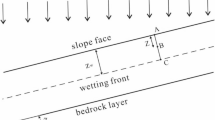Abstract
Rainfall during summer season is one of the major causes of slope failure in Korea, especially in unsaturated weathered granite soils. The current slope design procedure for the rainy season is to just raise the ground-water level, which is not adequate for the unsaturated soil slope. Previous rainfall hazard envelopes only tend to use rainfall intensity and duration as the main variables, not considering mechanical and hydraulic characteristics of unsaturated soils. The general equation for Factor of Safety (FS) in infinite unsaturated slopes is derived to consider the rainfall infiltration. The three important factors governing the equation are as follows: rainfall characteristics such as intensity and duration to determine a wetting front depth using an infiltration model, shear strength theory for unsaturated soil, and variation of suction profile during rainfall. The minimal FS is calculated from the FS profile with depth for a given rainfall intensity and duration, and a rainfall hazard envelope considering soil infiltration characteristics is built for a given slope angle. The procedure to develop a hazard envelope for various slope angles is applied to three unsaturated weathered granite soils in Korea.
Similar content being viewed by others
References
ASCE (1996). Hydrology handbook, 2nd Edition, ASCE Manual No. 28, 1996.
Caine, N. (1980). “The rainfall intensity-duration control of shallow landslides and debris flows.” Geogr. Ann. A, Vol. 62, Nos. 1–2, pp. 23–27.
Chleborad, A. F. Baum, R. L., and Godt, J. W. (2006). Rainfall thresholds for forecasting landslides in the Seattle, Washington, area — exceedance and probability, U.S. Geological Survey.
Cho, S. E. and Lee, S. R. (2002). “Evaluation of surficial stability for homogeneous slopes considering rainfall characteristics.” J. Geotech. Geoenviron. Eng., Vol. 128, No. 9, pp. 756–763.
Collins, B. D. and Znidarcic, D. (2004). “Stability analyses of rainfall induced landslides.” J. Geotech. Geoenviron. Eng., Vol. 130, No. 4, pp. 362–372.
Fredlund, D. G., Morgenstern, N. R., and Widger, R. A. (1978). “The shear strength of unsaturated soils.” Canadian Geotechnical Journal, Vol. 15, No. 3, pp. 313–321.
Fredlund, D. G. and Xing, A. (1994). “Equations for the soil-water characteristic curve.” Canadian Geotechnical Journal, Vol. 31, No. 4, pp. 521–532.
Green, W. H. and Ampt, G. A. (1911). “Studies on soil physics I. The flow of air and water through soils.” Journal of Agricultural Research, Vol. 4, No. 1, pp. 1–24.
Guzzetti, F., Peruccacci, S., Rossi, M., and Stark, C. P. (2008). “The rainfall intensity-duration control of shallow landslides and debris flows: an update.” Landslides, Vol. 5, pp. 3–17.
Iverson, R. M. (2000). “Landslide triggering by rain infiltration.” Water Resource Research, Vol. 36, No. 7, pp. 1897–1910.
Jeong, S. S., Choi, J. Y., and Lee, J. H. (2009). “Stability analysis of unsaturated weathered soil slopes considering rainfall duration.” Journal of the Korean Society of Civil Engineers, KSCE, Vol. 29, No. 1C, pp. 1–9.
Kim, J., Jeong, S., Park, S., and Sharma, J. (2004). “Influence of rainfall-induced wetting on the stability of slopes in weathered soils.” Engineering Geology, Vol. 75, Nos. 3–4, pp. 251–262.
Lee, M. L., Gofar, N., and Rahardjo, H. (2009). “A simple model for preliminary evaluation of rainfall-induced slope instability.” Engineering Geology, Vol. 108, Nos. 3–4, pp. 272–285.
Li, A. G., Tham, L. G., Yue, G. Q., Lee, C. F., and Law, K. T. (2005). “Comparison of field and laboratory soil-water characteristic curves.” J. Geotech. Geoenviron. Eng., Vol. 131, No. 9, pp. 1176–1180.
Lu, N. and Likos, W. J. (2006). “Suction stress characteristic curve for unsaturated soil.” J. Geotech. Geoenviron. Eng., Vol. 132, No. 2, pp. 131–142.
Mein, R. G. and Larson, C. L. (1973). “Modeling infiltration during a steady rain.” Water Resources Research, Vol. 9, No. 2, pp. 384–394.
NIDP (2010). Model development to evaluate geotechnical disaster on steep slope considering rainfall and infiltration characteristics, National Institute of Disaster Prevention, Research Report.
Rahardjo, H., Lim, T. T., Chang, M. F., and Fredlund, D. G. (1995). “Shear strength characteristics of a residual soil.” Canadian Geotechnical Journal, Vol. 32, No. 1, pp. 60–77.
Author information
Authors and Affiliations
Corresponding author
Rights and permissions
About this article
Cite this article
Shin, H., Kim, Y.T. & Park, D.K. Development of rainfall hazard envelope for unsaturated infinite slope. KSCE J Civ Eng 17, 351–356 (2013). https://doi.org/10.1007/s12205-013-1626-9
Received:
Revised:
Accepted:
Published:
Issue Date:
DOI: https://doi.org/10.1007/s12205-013-1626-9




